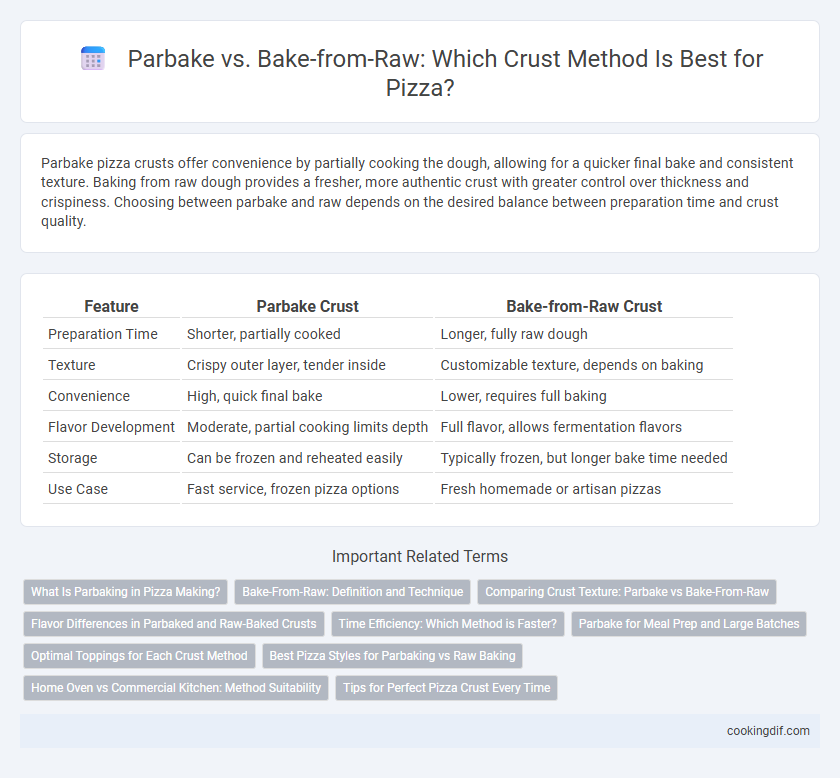Parbake pizza crusts offer convenience by partially cooking the dough, allowing for a quicker final bake and consistent texture. Baking from raw dough provides a fresher, more authentic crust with greater control over thickness and crispiness. Choosing between parbake and raw depends on the desired balance between preparation time and crust quality.
Table of Comparison
| Feature | Parbake Crust | Bake-from-Raw Crust |
|---|---|---|
| Preparation Time | Shorter, partially cooked | Longer, fully raw dough |
| Texture | Crispy outer layer, tender inside | Customizable texture, depends on baking |
| Convenience | High, quick final bake | Lower, requires full baking |
| Flavor Development | Moderate, partial cooking limits depth | Full flavor, allows fermentation flavors |
| Storage | Can be frozen and reheated easily | Typically frozen, but longer bake time needed |
| Use Case | Fast service, frozen pizza options | Fresh homemade or artisan pizzas |
What Is Parbaking in Pizza Making?
Parbaking in pizza making involves partially baking the crust to set its structure before freezing or storing, allowing for quicker final baking and a crispier texture. This method reduces cooking time and ensures a consistent, evenly cooked crust compared to baking from raw, which requires longer oven time and careful monitoring to avoid undercooked dough. Parbaked crusts are ideal for busy kitchens and frozen pizza products, providing convenience without sacrificing quality.
Bake-From-Raw: Definition and Technique
Bake-from-raw pizza crust involves preparing the dough from scratch and baking it without any prior cooking steps, ensuring a fresher, more authentic texture and flavor. This technique requires precise control of oven temperature and baking time to achieve a crisp, golden-brown crust while maintaining a chewy interior, which is preferred by artisanal pizza makers. Using high-protein flour and allowing the dough to ferment improves gluten development, enhancing the crust's rise and chewiness during the bake-from-raw process.
Comparing Crust Texture: Parbake vs Bake-From-Raw
Parbaking pizza crust results in a firmer and slightly chewy texture with a golden-brown exterior, while baking-from-raw produces a softer, more doughy bite that absorbs toppings better. Parbaked crusts reduce cooking time and maintain structural integrity, making them ideal for thick, stuffed, or Neapolitan-style pizzas. Raw dough baking allows for more airiness and crispness, enhancing flavor through Maillard reactions and steam release during the baking process.
Flavor Differences in Parbaked and Raw-Baked Crusts
Parbaked pizza crust offers a slightly crisp texture with a milder, more uniform flavor due to the partial pre-baking process that locks in moisture. Raw-baked crusts develop deeper, more complex flavors as the dough fully ferments and caramelizes during baking, producing a richer, more robust taste profile. The choice between parbaked and raw-baked crusts significantly impacts the final flavor intensity and textural contrast of the pizza.
Time Efficiency: Which Method is Faster?
Parbaked pizza crusts cut down overall preparation time by partially baking the crust in advance, allowing for faster final assembly and baking, typically taking around 10-15 minutes. In contrast, bake-from-raw crust requires full baking time, often 15-20 minutes or more, due to raw dough needing complete cooking to achieve the ideal texture and flavor. Parbaking offers significant time efficiency for quick pizza service without compromising crust quality.
Parbake for Meal Prep and Large Batches
Parbaking pizza crust allows for efficient meal prep by partially cooking the dough, which preserves texture and prevents sogginess during storage. This method is ideal for large batches, as parbaked crusts can be frozen and quickly finished with toppings before serving, saving time on busy days. It ensures consistent quality and reduces overall cooking time compared to baking from raw dough each time.
Optimal Toppings for Each Crust Method
Parbaked pizza crusts maintain a firm texture that supports heavier, moisture-rich toppings like sausage, mushrooms, and extra cheese without becoming soggy. Bake-from-raw crusts are ideal for lighter toppings such as fresh vegetables and thinly sliced meats, as they develop a crispier base that balances moisture release during baking. Selecting toppings based on the crust's baking method enhances overall texture and flavor integration in the final pizza.
Best Pizza Styles for Parbaking vs Raw Baking
Parbaking pizza crust offers precise control over texture, making it ideal for Neapolitan and New York-style pizzas that benefit from a chewy yet crisp base. Raw baking allows deeper flavor development and is preferred for thick-crust styles like Chicago deep-dish and Sicilian, where the dough requires full rising and baking to achieve optimal softness and density. Choosing between parbake and raw bake impacts crust hydration, crumb structure, and overall taste, directly influencing the finished pizza's quality depending on style.
Home Oven vs Commercial Kitchen: Method Suitability
Parbaked crusts offer consistency and time efficiency ideal for commercial kitchens with high volume demand, where quick turnaround is essential. Home ovens benefit from bake-from-raw crusts as they allow better control over texture and doneness, optimizing flavor in smaller batches. Commercial kitchens prioritize parbaked methods for operational speed, while home cooks prefer raw dough to tailor crust crispness and chewiness.
Tips for Perfect Pizza Crust Every Time
For perfect pizza crust every time, parbaking the dough before adding toppings ensures a crispier base by partially cooking the crust and preventing sogginess. Baking-from-raw can yield a chewier texture but requires careful temperature control and longer cooking times to avoid undercooked centers. Using a pizza stone or steel and preheating the oven to 500degF (260degC) optimizes heat distribution, enhancing crust texture regardless of parbake or raw methods.
Parbake vs bake-from-raw for crust Infographic

 cookingdif.com
cookingdif.com